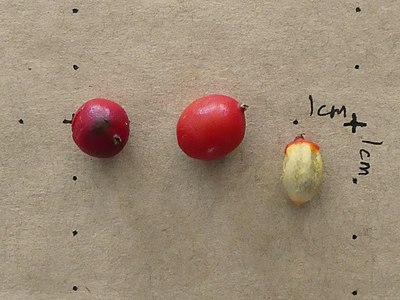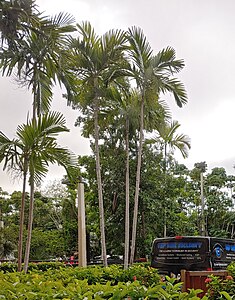| Solitaire palm | |
|---|---|

| |
| Conservation status | |
| Least Concern (NCA) | |
| Scientific classification | |
| Kingdom: | Plantae |
| Clade: | Tracheophytes |
| Clade: | Angiosperms |
| Clade: | Monocots |
| Clade: | Commelinids |
| Order: | Arecales |
| Family: | Arecaceae |
| Genus: | Ptychosperma |
| Species: | P. elegans |
| Binomial name | |
| Ptychosperma elegans (R.Br.) Blume | |
| Synonyms | |
| |
Ptychosperma elegans, commonly known as the solitaire palm (or elegant palm after the scientific name), is a very slender palm endemic to Queensland in Australia. In the nursery trade and in the United States it may be confusingly referred to as Alexander palm, which is an often-used but misnomered name of another Australian palm species Archontophoenix alexandrae, the Alexandra palm (note the difference in gender between the two names).
Description
Ptychosperma elegans is a solitary-stemmed palm growing to a height of 10–12 m (33–39 ft). The slender stem measures up to 8–10 cm (3.1–3.9 in) in diameter, is slightly bulging at the base, is light grey in colour, and has prominent leaf scars encircling the trunk.
The crown usually has 7 to 11 pinnate fronds that reach lengths of around 3 metres (9.8 ft). The petiole (leaf stem) is around 30 cm (12 in) long; the crownshaft around 60 cm (24 in) long and mid-green in colour with a whitish waxy coating. The pinnae (leaflets) number between 30 and 60 on each side of the rachis or midrib, measure up to 84 cm (33 in) in length at the middle of the frond and shorter at each end, and have an obliquely praemorse tip (i.e. with a jagged edge like a fishtail).
Inflorescences are about 70 cm (28 in) long and produced on the trunk just below the crownshaft. Flowers are grouped in sets of 3, each with one pistillate (functionally female) and two staminate (functionally male) flowers. They are light green with 3 sepals and 3 petals; staminate flowers are about 6 mm (0.24 in) long with 12-22 stamens, pistilate flowers measure about 5 mm (0.20 in) and have 6 staminodes and a 1 mm (0.039 in) recurved stigma.
Fruits of Ptychosperma elegans measure 9–15 mm (0.35–0.59 in) long and 8–10 mm (0.31–0.39 in) wide, are bright red when ripe and the remains of the stigma is attached at one end. There is a thin layer of flesh around the solitary seed, which is about 10 mm (0.39 in) long and 7 mm (0.28 in) wide with five deep longitudinal grooves.
Taxonomy and etymology
Originally described as Seaforthia elegans in 1810 by Robert Brown in his work Prodromus Florae Novae Hollandiae et Insulae Van Diemen, it was given its current binomial name in 1843 by Carl Ludwig Blume in his publication Rumphia, sive, Commentationes botanicæ imprimis de plantis Indiæ Orientalis.
The genus name Ptychosperma is derived from the Ancient Greek word ptukhḗ, meaning "a fold"; and spérma, "seed". The species epithet elegans comes from the Latin term ēlegāns meaning "graceful" or "elegant".
Distribution and habitat
The species is endemic to Queensland, Australia, where it grows in both tropical and sub-tropical rainforests as an understory tree, often close to rivers and streams where there is plentiful water and good drainage. Its altitudinal range is from sea level to 900 m (3,000 ft).
Cultivation
The tropical species is a popular palm in gardens and parks, where its arched crown, slender trunk, and red fruit are regarded as appealing feature. They are less successful in cooler climates and somewhat to susceptible to frosts. Plants grown in pots or indoors require high amounts of light with humid and warm conditions. A blight that covers leaves with dark brown patches, especially in sub-tropical climates, does not seem to interfere with a specimen's growth. Ptychosperma elegans is cultivated as an ornamental tree for planting in temperate climate gardens and parks. It is a single trunked tree, that in cultivation can reach 20–40 feet (6.1–12.2 m) in height.
It has been naturalized in South Florida since at least the 1950s, and remains the only member of its genus naturalized in the USA. Due to its intolerance of cold, it is mostly found in South Florida and coastal Tampa. It also is used in Coastal Southern California, primarily Orange and San Diego counties.
Gallery
-
 Inflorescence
Inflorescence
-
 Characteristic blunt leaf tips
Characteristic blunt leaf tips
-
 Fruits and seed
Fruits and seed
-
 Staminate flowers
Staminate flowers
-
 Group of mature trees in Miami Florida
Group of mature trees in Miami Florida
-
 Laden with fruit
Laden with fruit
-
 Group in Englewood Florida
Group in Englewood Florida
See also
- Archontophoenix alexandrae — the similarly named Alexandra palm
- Adonidia — a palm genus with similar appearance
References
- ^ "Species profile—Ptychosperma elegans (solitaire palm)". Environment, Land and Water. Queensland Government. 20 October 2014. Retrieved 24 March 2021.
- "Ptychosperma elegans (R.Br.) Blume". Australian Plant Names Index (APNI). Centre for Plant Biodiversity Research, Australian Government. Retrieved 24 March 2021.
- ^ "Ptychosperma elegans (R.Br.) Blume". Plants of the World Online. Royal Botanic Gardens, Kew. Retrieved 24 March 2021.
- ^ F.A. Zich; B.P.M Hyland; T. Whiffen; R.A. Kerrigan (2020). "Ptychosperma elegans". Australian Tropical Rainforest Plants, Edition 8. Commonwealth Scientific and Industrial Research Organisation (CSIRO). Retrieved 24 March 2021.
- Palmpedia: Ptychosperma elegans
- ^ "Ptychosperma elegans (solitaire palm)". Invasive Species Compendium. CAB International. Retrieved 28 March 2021.
- ^ "Ptychosperma elegans". Identifying Commonly Cultivated Palms. United States Department of Agriculture (USDA). Retrieved 28 March 2021.
- "Rumphia, sive, Commentationes botanicæ imprimis de plantis Indiæ Orientalis". International Plant Names Index (IPNI). Royal Botanic Gardens, Kew. Retrieved 29 March 2021.
- "Rumphia, sive, Commentationes botanicæ imprimis de plantis Indiæ Orientalis". Biodiversity Heritage Library. Retrieved 29 March 2021.
- Cooper, Wendy; Cooper, William T. (June 2004). Fruits of the Australian Tropical Rainforest. Clifton Hill, Victoria, Australia: Nokomis Editions. p. 74. ISBN 9780958174213. Retrieved 13 April 2021.
- Jones, David L. (1996). Palms in Australia (3rd ed.). Port Melbourne: Reed Books. p. 107. ISBN 0730104907.
- Dave's Garden Blog: Solitaire Palm (Ptychosperma elegans)
External links
 Media related to Ptychosperma elegans at Wikimedia Commons
Media related to Ptychosperma elegans at Wikimedia Commons Data related to Ptychosperma elegans at Wikispecies
Data related to Ptychosperma elegans at Wikispecies- PACSOA—Palm and Cycad Societies of Australia wiki: Ptychosperma elegans (Solitaire palm) — with images
- USDA Plants Profile for Ptychosperma elegans (Alexander palm)
| Taxon identifiers | |
|---|---|
| Ptychosperma elegans |
|